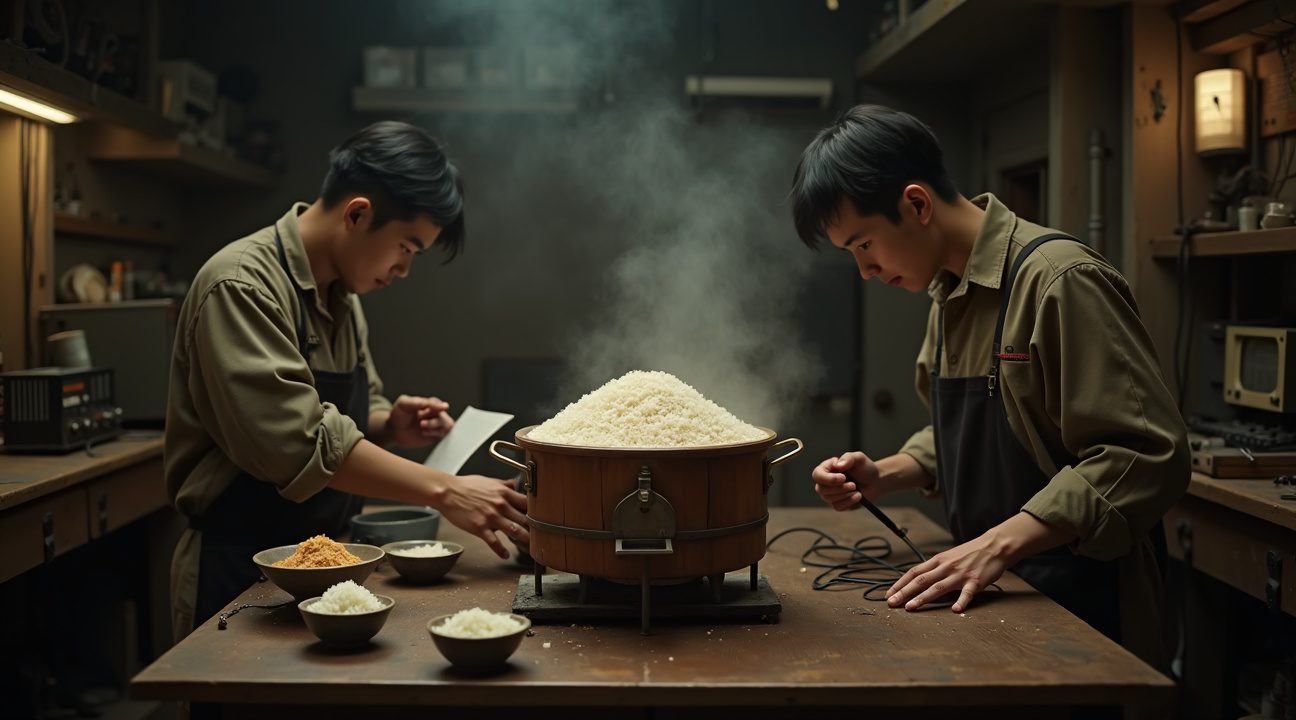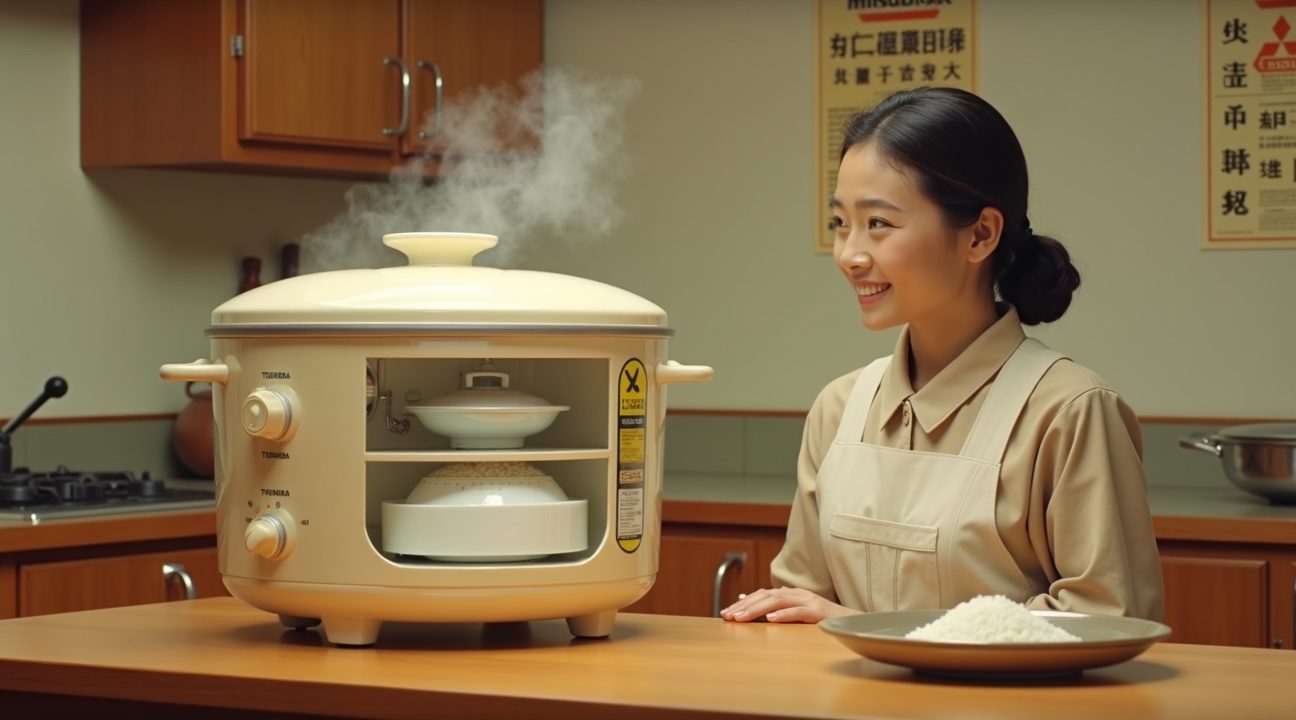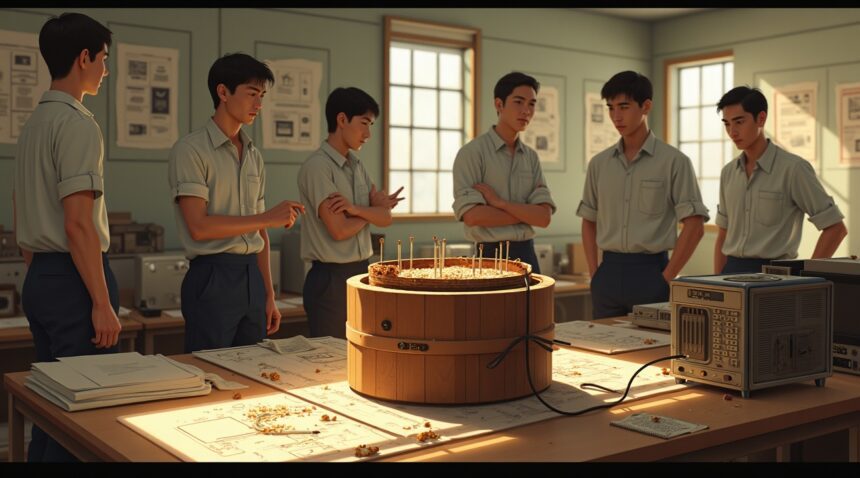Sony’s journey began in the late 1940s with an ambitious but flawed first product—an electric rice cooker featuring electrodes embedded in a wooden tub that consistently burned or undercooked rice due to unreliable temperature control and poor automation.
This commercial failure taught Sony’s founders crucial lessons about product development, quality control, and market readiness. Those lessons would shape their approach to future innovations and ultimately contribute to their evolution into a global electronics empire.
Key Takeaways
- Sony’s first product was a wooden electric rice cooker in the late 1940s that used rice to complete an electrical circuit. It failed commercially due to inconsistent cooking results and poor temperature control.
- The rice cooker failure taught Sony valuable lessons about product development, market research, and consumer needs. These insights influenced their later success with products like the transistor radio, Walkman, and PlayStation.
- Toshiba’s breakthrough came in 1955–1956 with the ER-4, the world’s first automatic electric rice cooker. It featured double-layer construction and thermostat technology and reached half of Japanese households by 1960.
- Rice cooker evolution advanced from basic automation to sophisticated technology. Innovations included heat retention in 1972, microcomputer control in 1979, and electromagnetic induction heating in 1988.
- The rice cooker revolution transformed domestic life by cutting cooking time and reducing household tasks. It also solidified Japan’s culture of technological innovation, significantly influencing the global electronics industry.
For more on the development of cooking technology, visit this detailed history of rice cookers on Wikipedia.
Sony’s Failed Rice Cooker: A Wooden Tub That Burned More Than It Cooked
Sony’s journey began with an ambitious yet flawed attempt at solving a fundamental problem in post-war Japan. The Tokyo Telecommunications Engineering Corporation, as Sony was originally known, developed their first product in the late 1940s—an electric rice cooker that would become a lesson in the importance of proper engineering and market readiness.
The Wooden Wonder That Wasn’t
The device itself was remarkably simple in concept but problematic in execution. Engineers embedded basic electrodes directly into a wooden tub, creating what they believed would be an automated cooking solution. The rice cooker relied on the rice itself to complete the electrical circuit during the cooking process. Once the rice absorbed enough water and reached the proper consistency, it would theoretically break the circuit and stop the heating process.
This crude automation system reflected the limited technology available in post-war Japan, but it also demonstrated the company’s early willingness to experiment with consumer electronics. The wooden construction made the device affordable to manufacture, though it contributed significantly to the performance issues that would ultimately doom the product.
When Inspiration Meets Reality
The inspiration for this rice cooker came from personal necessity rather than market research. Sony’s founders, including Masaru Ibuka, were partly compensated with rice during Japan’s challenging post-war economic recovery period. This direct experience with rice as both sustenance and currency motivated them to create a device that could improve the cooking process for families across Japan.
Unfortunately, the cooker’s performance rarely matched its creators’ intentions. The temperature control system proved unreliable, leading to consistently disappointing results. Users frequently discovered their rice had either burned to an inedible crisp or remained stubbornly undercooked and inedible. The wooden construction, while cost-effective, couldn’t provide the even heat distribution necessary for consistent cooking results.
Poor automation compounded these problems. The circuit-breaking mechanism that should have stopped the cooking process at the optimal moment often failed to engage properly. Sometimes the device would continue heating long after the rice was ready, while other times it would shut off prematurely, leaving families with partially cooked meals.
These fundamental design flaws prevented the rice cooker from ever reaching mass production or widespread distribution. The company’s founders quickly recognized that their first attempt at consumer electronics needed significant refinement before it could compete in the marketplace.
The failure taught Sony valuable lessons about product development, quality control, and market expectations that would shape their approach to future innovations. While the rice cooker never succeeded commercially, it established important precedents for the company’s commitment to solving everyday problems through technology.
This early setback didn’t discourage Sony’s founders from pursuing consumer electronics. Instead, it reinforced their understanding that successful products required not just innovative concepts but also reliable execution and thorough testing. The experience with the wooden rice cooker became part of Sony’s foundational learning process, contributing to their later success with gaming consoles and other consumer electronics.
The wooden rice cooker represents more than just a failed product—it symbolizes Sony’s willingness to take risks and learn from mistakes. This early experiment in automation and consumer convenience would eventually evolve into the sophisticated electronics that made Sony a household name worldwide. The lessons learned from this humble beginning helped shape the company’s approach to product development and market entry strategies that would prove successful for decades to come.

Toshiba’s Breakthrough: The World’s First Automatic Rice Cooker Changed Everything
The landscape of Japanese kitchen appliances transformed dramatically in the mid-1950s when Toshiba released the ER-4 model around 1955 or 1956. While companies like Mitsubishi Electric had introduced industrial electric rice cookers as early as 1923, and manufacturers including Sony, Panasonic (then Matsushita Electric), and Mitsubishi had made various enhancements throughout the 1940s and 1950s, these early models suffered from critical limitations. They lacked proper automation and failed to capture commercial appeal among average consumers.
Revolutionary Design Features
Toshiba’s ER-4 broke new ground by becoming the world’s first automatic electric rice cooker specifically designed for household use. The device featured several innovative elements that set it apart from previous attempts:
- A double-layer construction that provided superior heat distribution
- An integrated thermostat system that monitored cooking temperature
- Automatic shut-off functionality when water evaporated completely
- Temperature-sensing technology that detected the sudden rise indicating completion
The thermostat represented the game-changing innovation. When all water had evaporated during the cooking process, the internal temperature would rise suddenly, triggering the automatic shut-off mechanism. This eliminated the guesswork and constant monitoring that plagued earlier rice cooking methods.
The ER-4’s price point of 3,200 yen positioned it as a premium appliance—approximately one-third of a new college graduate’s monthly salary at launch. Despite this substantial investment, consumers recognized the value proposition immediately. The convenience of automated rice preparation justified the expense for families seeking to modernize their kitchens.
Market adoption exceeded all expectations. By 1960, automatic rice cookers had penetrated half of all Japanese households, demonstrating the profound impact of Toshiba’s innovation. This rapid acceptance established rice cookers as essential kitchen appliances rather than luxury items.
The success of the ER-4 also demonstrated how technological refinement could transform everyday activities. Previous rice cooking required careful timing, constant attention, and considerable skill to achieve consistent results. Toshiba’s automated approach eliminated these challenges while maintaining quality.
The ER-4’s influence extended beyond immediate commercial success. It established the foundation for modern rice cooker technology and inspired countless improvements from competing manufacturers. Companies began developing their own variations, leading to features like programmable timers, multiple cooking modes, and enhanced heating elements.
This breakthrough also highlighted how consumer electronics companies could successfully enter appliance markets by focusing on automation and user convenience. Sony’s early involvement in rice cooker development during the 1940s and 1950s provided valuable experience that would later inform their approach to other consumer electronics.
The rapid household adoption rate revealed changing domestic priorities in post-war Japan. Families increasingly valued time-saving devices that could streamline daily routines. The rice cooker’s success predicted similar acceptance patterns for other automated appliances in subsequent decades.
Toshiba’s achievement with the ER-4 proved that successful product innovation required more than basic functionality. The combination of reliable automation, practical design, and reasonable pricing created a winning formula that competitors would study and attempt to replicate across various product categories.

The Rice Cooker Revolution: From Simple Automation to Smart Technology
The rice cooker industry experienced rapid transformation after Sony’s initial foray into the market. I witnessed how competitors quickly recognized the potential of automated rice cooking, leading to innovations that would reshape kitchen technology forever.
Industry Competition Drives Innovation
Matsushita Electric responded to the growing market in 1956 by launching the EC-36, a more affordable alternative to Toshiba’s existing rice cooker. This single-pot design democratized rice cooking automation, making it accessible to households that couldn’t afford premium models. Competition intensified as manufacturers realized they could capture significant market share by improving functionality while reducing costs.
The 1970s brought a game-changing advancement when manufacturers introduced heat-retention functions in 1972. Rice cookers could now keep rice warm for extended periods, eliminating the need for immediate consumption after cooking. This feature addressed a practical concern for families who wanted flexibility in meal timing.
The Digital Revolution in Kitchen Appliances
Microcomputer technology revolutionized rice cookers in 1979, introducing precision control that seemed impossible just decades earlier. These smart devices could adjust cooking times and temperatures automatically, accommodating different rice varieties and quantities. I’ve observed how this technological leap paralleled Sony’s evolution into digital entertainment, showing how electronics companies adapted similar innovations across product lines.
Electromagnetic induction heating arrived in 1988, representing the pinnacle of rice cooker evolution. This technology offered superior heat distribution and energy efficiency compared to traditional heating elements. Manufacturers could now provide consistent results regardless of external factors like ambient temperature or humidity levels.
These innovations transformed rice cookers from basic appliances into sophisticated kitchen computers. Modern versions feature multiple cooking programs, fuzzy logic controllers, and smartphone connectivity. The progression from Sony’s simple aluminum pot to today’s AI-powered cookers demonstrates how consumer electronics evolved from mechanical solutions to intelligent systems. Each advancement built upon previous innovations, creating appliances that anticipate user needs rather than simply following basic commands.
The rice cooker’s evolution mirrors broader trends in consumer electronics, where companies continuously refined products to meet changing lifestyle demands. What began as Sony’s attempt to solve a simple cooking problem became a template for how technology could enhance everyday activities through automation and intelligence.
How Sony Learned From Failure and Built an Electronics Empire
The rice cooker disaster taught Masaru Ibuka and his team invaluable lessons about product development, market research, and the importance of understanding consumer needs. Rather than abandoning their dreams of creating innovative electronics, Ibuka and his colleagues channeled their learnings into developing products that would actually solve real problems for consumers.
Sony’s first breakthrough came in 1947 with the ‘Power Megaphone,’ marking the company’s initial commercial success. This product demonstrated that the engineering talent within the organization could create viable solutions when properly focused on market demands. The megaphone’s success provided the financial foundation and confidence needed to pursue more ambitious projects.
Building on this momentum, Sony achieved another significant milestone by creating Japan’s first tape recorder. This accomplishment positioned the company as a serious player in the electronics industry and showcased their ability to adapt foreign technologies for the Japanese market. The tape recorder success proved that Sony could compete with established international brands while developing products specifically suited for local consumers.
Key Innovations That Defined Sony’s Evolution
- The transistor radio revolutionized portable music consumption and demonstrated Sony’s ability to miniaturize complex technology
- Television sets helped establish Sony as a household name across Japan and eventually internationally
- The iconic Walkman created an entirely new product category and changed how people experienced music
- The PlayStation gaming console expanded Sony’s reach into interactive entertainment and mobile gaming
Each of these products reflected lessons learned from the rice cooker failure. Ibuka and his team realized that successful products required more than just clever engineering – they needed to address genuine consumer needs while being technically reliable and competitively priced.
The company’s leadership understood that high-quality technology alone wasn’t sufficient for market success. Products also needed to be launched at the right time when consumers were ready to adopt new technologies. This timing consideration became a hallmark of Sony’s product development strategy, helping them avoid the premature market entry that had doomed their rice cooker.
Innovation became Sony’s defining characteristic, but it was innovation guided by market awareness rather than pure technical curiosity. The company learned to balance cutting-edge engineering with practical consumer applications, ensuring that their products would find eager buyers rather than confused potential customers.
Sony’s commitment to preserving their rice cooker prototype in the corporate museum in Shinagawa, Tokyo, demonstrates how the company views failure as part of their innovation journey. This artifact serves as a reminder that even the most successful companies experience setbacks and that learning from these failures often leads to greater achievements.
The transformation from kitchen appliance manufacturer to electronics empire illustrates how companies can pivot successfully when they’re willing to acknowledge mistakes and adapt their strategies. Sony’s evolution shows that initial product failures don’t necessarily predict future success or failure – what matters is how organizations respond to those early challenges.
Today, Sony continues to innovate across multiple entertainment and technology sectors, from PlayStation gaming consoles to entertainment content. The lessons learned from that failed rice cooker continue to influence how the company approaches new product development, ensuring that market readiness and consumer needs remain central to their innovation process. The rice cooker’s legacy lives on not as a cautionary tale, but as the foundation stone of one of the most successful electronics companies in history.

The Unexpected Legacy: How Rice Cookers Changed Society and Inspired Innovation
The introduction of automatic rice cookers fundamentally transformed domestic life across Japan and eventually spread worldwide. These simple appliances cut cooking time dramatically, allowing families to prepare perfectly cooked rice without constant monitoring. I’ve observed how this innovation freed up valuable time for other household activities and meal preparation tasks.
The societal impact extended far beyond mere convenience. Women, who traditionally bore the responsibility of meal preparation, suddenly found themselves with additional time each day. This seemingly small change contributed to early movements supporting women’s liberation by reducing the daily domestic burden. Families could now allocate time previously spent stirring and watching rice pots to other pursuits, whether educational, professional, or recreational.
Innovation Culture and Sony’s Pioneering Spirit
Sony’s rice cooker venture, despite its commercial failure, established a crucial foundation for Japan’s technology sector. The company’s willingness to experiment with domestic appliances demonstrated an innovative mindset that would later influence countless other manufacturers. This early foray into consumer electronics taught valuable lessons about product development, market research, and consumer needs.
The failed rice cooker project didn’t discourage Sony’s leadership. Instead, it reinforced their commitment to experimentation and risk-taking. This philosophy became central to Sony’s identity and later drove their success in developing groundbreaking products. Sony’s mobile gaming division represents just one example of how this innovative spirit continues today.
Japanese companies watched Sony’s bold attempt and learned from both its technical achievements and market missteps. The culture of continuous experimentation that Sony helped establish became a hallmark of Japan’s technology industry. Companies began viewing failure as a stepping stone rather than an endpoint, encouraging more ambitious projects and breakthrough innovations.
Rice cookers eventually became indispensable appliances throughout Asia. Households in Japan, China, Korea, and Southeast Asian countries adopted these devices as essential kitchen equipment. The perfect rice these machines produced became a standard expectation rather than a luxury.
The technology spread beyond Asia as immigration patterns and cultural exchange introduced rice cookers to new markets. Hawaii became an early adopter in the United States, where large Asian populations appreciated the convenience and consistency these appliances offered. California followed suit, particularly in areas with significant Asian communities.
Louisiana presented an interesting case study in rice cooker adoption. The state’s strong rice-eating traditions, influenced by Creole and Cajun cuisines, created natural demand for reliable cooking methods. Rice cookers found their way into Louisiana kitchens, proving their versatility across different cultural contexts.
The appliances’ influence on Sony’s strategic planning became evident in later product developments. The company learned valuable lessons about consumer behavior, market timing, and product positioning that informed future ventures. These insights proved crucial when Sony eventually dominated the electronics and entertainment industries.
Modern rice cookers bear little resemblance to Sony’s original aluminum pot design. Today’s models feature digital controls, multiple cooking modes, and smart connectivity options. Some units can prepare various grains, steam vegetables, and even bake cakes. The evolution from Sony’s simple prototype to today’s sophisticated appliances illustrates how innovation builds upon previous attempts.
The rice cooker’s journey from Sony’s experimental laboratory to millions of kitchens worldwide demonstrates how failed products can still generate lasting impact. Sony’s early attempt established technical foundations, market awareness, and cultural acceptance that later manufacturers refined and perfected. The company’s willingness to tackle everyday problems with technological solutions became a defining characteristic that influenced everything from PlayStation pricing strategies to entertainment content development.
Sources:
Wikipedia – “Rice cooker”
MyITRetrieval – “Sony’s First Product Wasn’t a TV… It Was a Rice Cooker”
Greedy Panda Foodie Blog – “The origin of the electric rice cooker”
Atlas Obscura – “The Battle to Invent the Automatic Rice Cooker”
GSMArena – “It all began with a failed rice cooker – a glimpse at Sony’s history”


